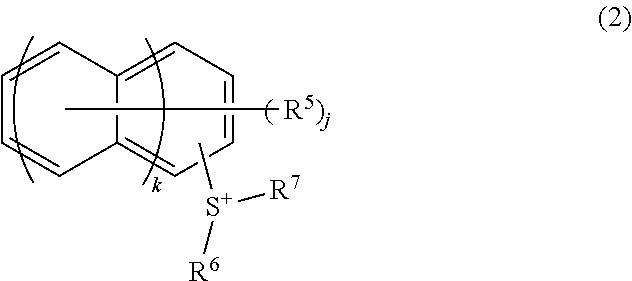Photoresist composition, resist pattern-forming method, compound, acid generating agent, and photodegradable base
a technology of resist pattern and composition, applied in the field of resist composition, can solve the problems of further elevated performance expectations of resist pattern, conventional photoresist compositions fail to sufficiently satisfy the resolving ability, etc., and achieve the effect of reducing lwr and superior resolution
- Summary
- Abstract
- Description
- Claims
- Application Information
AI Technical Summary
Benefits of technology
Problems solved by technology
Method used
Image
Examples
example 1
[0290]The compound (1) (acid generating agent (B-1)) was synthesized in accordance with the following scheme.
[0291]4-Bromo-3,3,4,4-tetrafluoro-1-butene and one equivalent of dicyclopentadiene were mixed, and the mixture was heated at 170° C. for 10 hours. A norbornene derivative was obtained after purification by column chromatography. The norbornene derivative was dissolved in dichloromethane to provide a 1 M solution, and 1.2 equivalents of m-chloroperoxybenzoic acid (mCPBA) was added to this solution with cooling at 0° C., followed by stirring at room temperature for 10 hours. The generated carboxylic acid was removed by filtration and washed twice with dichloromethane, and the solvent was distilled to obtain a crude epoxide derivative. To this, a liquid mixture of acetone:water:10% by mass sulfuric acid (5:2:3 (mass ratio)) was added to provide a 0.5 M solution, and the solution was stirred at 60° C. for 10 hours. After extraction with ethyl acetate, the extract was washed with ...
synthesis example 1
[0294]A monomer solution was prepared by dissolving 27.16 g (60 mol %) of the compound (M-1), 4.90 g (10 mol %) of the compound (M-2), and 17.94 g (30 mol %) of the compound (M-3) in 50 g of 2-butanone, and adding thereto 2.21 g (5 mol % with respect to the total number of moles of the monomers) of azobisisobutyronitrile (AIBN) as a radical initiator. Subsequently, 50 g of 2-butanone was charged into a 300 mL three-neck flask, and then the three-neck flask was purged with a nitrogen gas for 30 min. Thereafter the contents of the three-neck flask were heated to 80° C. while stirring with a magnetic stirrer, and the monomer solution prepared above was added dropwise over 3 hours with a dropping funnel. The time of the start of the dropwise addition was regarded as the time of the start of the polymerization reaction, and the polymerization reaction was allowed to proceed for 6 hours. After completing the polymerization, the polymerization solution was water-cooled to 30° C. or below. ...
synthesis example 2
[0295]After 55.0 g (65 mol %) of the compound (M-4) and 45.0 g (35 mol %) of the compound (M-5), 4 g (5 mol % with respect to the total number of moles of the monomers) of AIBN as well as 1 g of t-dodecyl mercaptan were dissolved in 100 g of propylene glycol monomethyl ether, the polymerization was allowed to proceed for 16 hours under a nitrogen atmosphere, while maintaining the reaction temperature of 70° C. After the polymerization, the reaction solution was added dropwise into 1,000 g of n-hexane, and a copolymer was solidified and purified. Then, after 150 g of propylene glycol monomethyl ether was again added to the copolymer, 150 g of methanol, 34 g of triethylamine and 6 g of water were further added, and the hydrolysis reaction was allowed to proceed for 8 hours while the mixture was refluxed at the boiling point thereof. After the reaction, the solvent and triethylamine were distilled under vacuum. The obtained copolymer was dissolved in 150 g of acetone, and then added dr...
PUM
| Property | Measurement | Unit |
|---|---|---|
| wavelength | aaaaa | aaaaa |
| wavelength | aaaaa | aaaaa |
| temperature | aaaaa | aaaaa |
Abstract
Description
Claims
Application Information
 Login to View More
Login to View More - R&D
- Intellectual Property
- Life Sciences
- Materials
- Tech Scout
- Unparalleled Data Quality
- Higher Quality Content
- 60% Fewer Hallucinations
Browse by: Latest US Patents, China's latest patents, Technical Efficacy Thesaurus, Application Domain, Technology Topic, Popular Technical Reports.
© 2025 PatSnap. All rights reserved.Legal|Privacy policy|Modern Slavery Act Transparency Statement|Sitemap|About US| Contact US: help@patsnap.com



